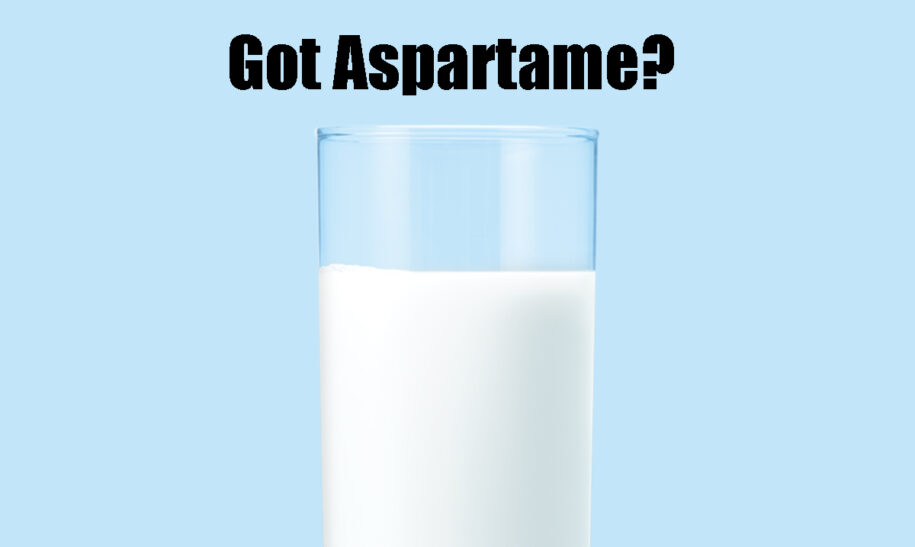Dairy Industry Trying to Hide Aspartame in New Definition of ‘Milk’
A petition was filed with the FDA by both the International Dairy Foods Association (IDFA) and the National Milk Producers Federation (NMPF) is requesting that the agency amend the definition of milk, as well as 17 other dairy products. Should this pass, artificial sweeteners such as aspartame and sucrose would not have to be listed on the product label.
Not only would the ingredients themselves not have to be listed, but milk producers wouldn’t even have to list phrases like ‘low-calorie’ or ‘calorie-free’ which can tip-off to consumers that the product may contain artificial sweeteners.

The Federal Register states, “[T]he proposed amendments would assist in meeting several initiatives aimed at improving the nutrition and health profile of food served in the nation’s schools. Those initiatives include state-level programs designed to limit the quantity of sugar served to children during the school day.”
Both the IDFA and NMPF argue that these changes would increase milk consumption in schools, as content claims such as ‘reduced calorie’ are not attractive to children, and therefore steer them away from the product.
They believe that due to the fact that consumers don’t generally recognize milk products as containing sugars, sweetening the products with artificial sweeteners instead of actual sugar would make it easier to identify its overall nutritional value.
The current legislation is already confusing, allowing producers to add sugar or high fructose corn syrup to their products while only labeling them as ‘milk’, however it does currently require that while artificial sweeteners can be added, they must be listed clearly. That’s right – your current dairy products may contain high fructose corn syrup without you even knowing it!
Should this petition pass, not only would the FDA amend the standards for milk, but also for 17 other milk and cream products including: acidified milk, cultured milk, sweetened condensed milk, non-fat dairy milk, non-fat dry milk fortified with vitamins A and D, evaporated milk, dry cream, heavy cream, light cream, sour cream, and acidified sour cream, light whipping cream, eggnog, half-and-half, yogurt, low-fat yogurt and non-fat yogurt.
Confused as to how this change would benefit Americans? You aren’t alone! One clue may come in reading a letter that was written by the NMPF to Julie Brewer, Chief of the Policy and Program Development Branch of the Child Nutition Division of the US Department of Agriculture (USDA) in response to a proposed rule to revise the nutrition requirements for the National School Lunch and Breakfast Programs. This proposed change would include limiting flavored milk products to only fat-free varieties. The NMPF letter read, in part:
”The proposed rule will not be a success if milk consumption drops as a result of flavored milk choices that are not appealing (or at least not as appealing as competitive beverages students may bring to school from elsewhere). Flavored milk was included as an option in the proposed rule in recognition that the small amount of added sugar (flavored milk contributes only 2-3% of added sugars to the diets of children and adolescents) is an acceptable trade-off for the extensive nutrient contribution flavored milk provides.”
“Therefore, NMPF urges the Department to modify the proposed rule to include both low-fat and fat-free flavored milk as options available to schools. To limit the potential for additional calories in a low-fat flavored milk (as compared to a fat-free formulation) we urge the establishment of a calorie limit on flavored milk of 150 calories per eight-ounce serving.”
“This will provide schools the flexibility to procure milk products that maintain high levels of acceptability and nutrient intake, while also assuring that flavored milk fits within overall calorie limits for meals. Many milk processors have proactively committed to and met a goal of 150 calories per serving as a way to limit the amount of sugar in flavored milk, and have worked within this constraint to formulate products that have demonstrated acceptability among students in schools across the country.”
Based on this letter, one can conclude that the purpose of the new proposed change of definition, like the purpose of the above letter, are two-fold; to fool children into drinking low-fat milk products, and to allow National School Lunch and Breakfast Programs to ‘look good’ in the eyes of the public by reducing the total calorie count of their provided meals, while at the same time helping to boost dairy industry profits.
While the commenting period for this petition is now closed, the debate continues. The industry has also moved on to further debate the term ‘milk’, as Diary producers are now calling for a crack down on plant-based ‘milks’ such as almond, soy and rice ‘milks’, claiming that they are masquerading as the real thing. The standard of identity for milk at this time states “complete milking of one or more healthy cows”, and as such the dairy industry is calling on the FDA to enforce these guidelines.
Which leaves us wondering, what really is in the products that we are drinking?


